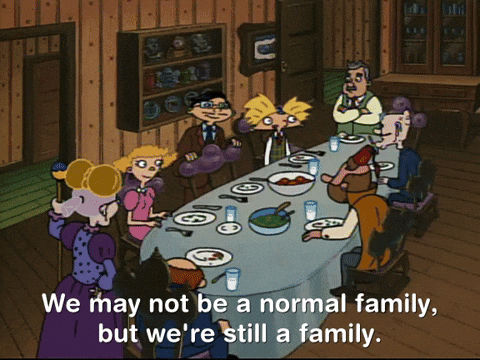When I was a child in the 80s, we had a yellow pine toothbrush holder in our bathroom – as I said it was the 80s and yellow pine was everywhere!
It had a large hole for a white mouth rinsing cup, and four smaller holes for toothbrushes.
The thing was we were a family of five.
My dad, always ready to make things right for us, tried to add some extra holes but his drill bit wasn’t quite big enough to make holes big enough for toothbrushes. So from that moment forward the rinsing cup stopped being used as a rinsing cup, and became a holder for ALL the toothbrushes.
What counts as a family, and what doesn’t, remains quietly folded into the design of everyday things.
That toothbrush holder and what a ‘normal family’ looks like, has been on my mind again - only this time it’s how the quiet assumption of ‘normal’ is baked into pricing. It’s quite astounding how many organisations only want to offer discounts to one type of family, and not others, and that family default is one of two adults and two children1.
It doesn’t stop at families with kids. So many discounts and offers often hinge on being a couple but only a specific type of couple, not for example a couple of best friends who have had each other’s backs for over 30 years2.
Audre Lourde talked about this normalisation of identities as a mythical norm, which, although not said out loud, is a quiet and powerful default factory setting, that everyone is implicitly compared against.
“Somewhere, on the edge of consciousness, there is what I call a mythical norm, which each one of us within our hearts knows "that is not me." In America, this norm is usually defined as white, thin, male, young, heterosexual, Christian, and financially secure. It is with this mythical norm that the trappings of power reside within this society. Those of us who stand outside that power often identify one way in which we are different”3
This week's question:
Why this question?
Traditional business advice favours simplicity where there is complexity. The family-of-four discount may be simple and straight-forward, but it’s not neutral, it excludes any ‘other’ type of family.
This idea of standardisation can exist throughout business, subtly upholding cultural and outdated ideals.
Pierre Bourdieu4 calls these unconscious, taken-for-granted beliefs ‘doxic knowledge’ assumptions that are rarely questioned and are deeply ingrained, even when they're harmful or outdated.
Noticing these quiet norms is doing business differently. It’s what lets us build tools that recognise there’s no such thing as a universal ‘normal’ and question what all that “it’s just the way to do it” advice was ever really trying to achieve. Because that kind of advice has impact. Impact that is felt and lived, and is still echoing through business ecosystems a long after the advice was given.
How to use this week's question:
Check where simplicity lives in your business: consider where your tools and processes assume ease, but at the expense of those who don’t fit the default.
Find your why: "why you've always done it this way”, “why this is just how you do things in business” and even “why would they even say that.”
Prepare for messy change: challenging the default can be uncomfortable but as Glennon Doyle and Abby Wambach say “We can do hard things.”
Be loud and proud when you find a better way: shout about it. Let’s make inclusive tools and processes not exceptional, but expected.
Keep questioning,
P.S. Do you know any organisations offering genuinely inclusive family pricing? I'd love to build a resource spotlighting those getting it right. Reply to this email with your examples.
Inspiration & Credits:
I hope giving some distance between sources and their links frees you from ended up in an unintended rabbit hole! If you’re interested though - click away!
Special shout out to St Paul’s Cathedral, who do offer varying family ticket offers – although I guess the non-normie family has always been at the heart of the Christian story.
h/t to my friend Laura for this perspective.
Audre Lourde, ‘Age, Race, Class and Sex: Women Redefining Difference’







